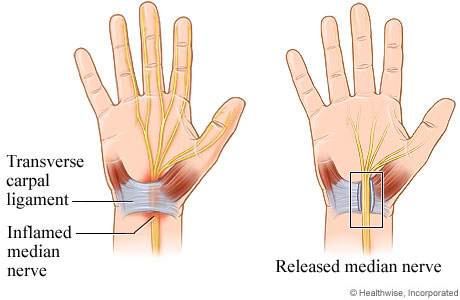 In the human body, the carpal tunnel or carpal canal is the passageway on the palmar side of the wrist that connects the forearm to the middle compartment of the deep plane of the palm. The tunnel consists of bones and connective tissue. Several tendons and the median nerve pass through it.
In the human body, the carpal tunnel or carpal canal is the passageway on the palmar side of the wrist that connects the forearm to the middle compartment of the deep plane of the palm. The tunnel consists of bones and connective tissue. Several tendons and the median nerve pass through it.
The canal is narrow, and when any of the nine long flexor tendons passing through it swell or degenerate, the narrowing of the canal often results in the median nerve becoming entrapped or compressed, a common medical condition known as carpal tunnel syndrome.
The carpus, the bony elements of the wrist, form an arch which is convex on the dorsal side of the hand and concave on the palmar side. The groove on the palmar side, the sulcus carpi, is covered by the flexor retinaculum, a sheath of tough connective tissue, thus forming the carpal tunnel. The flexor retinaculum is attached radially to the scaphoid tubercle and the ridge of trapezium, and on the ulna side to the pisiform and hook of hamate.
